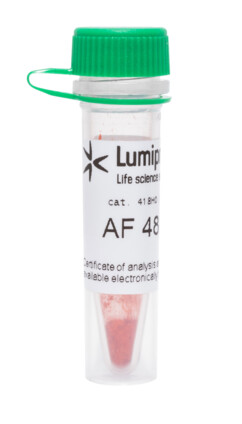Bis-ANS, protein conformation probe
| Cat. # | Quantity | Price | Lead time | Buy this product |
|---|---|---|---|---|
| 4381-5mg | 5 mg |
$159
|
in stock | |
| 4381-25mg | 25 mg |
$397
|
in stock |

Bis-ANS is a high-affinity fluorescent probe for nonpolar cavities in proteins. Its hydrophobic phenyl and naphthyl rings interact noncovalently with proteins and protein degradation products.
As with other anilinonaphthalene sulfonates (ANS), bis-ANS is essentially nonfluorescent in water but becomes noticeably fluorescent in a nonpolar environment. When free, bis-ANS has an excitation maximum at 390 nm and an emission maximum at 523 nm but undergoes a blue shift with an increase in fluorescence intensity when bound to protein.
Bis-ANS is frequently used to monitor the formation of protein aggregates and indicate protein folding and conformational changes. The dye is also used to detect Aβ fibers.
Excitation and emission spectra of protein complex with Bis-ANS

Customers also purchased with this product
General properties
| Appearance: | light yellow-green crystals |
| Molecular weight: | 672.87 |
| CAS number: | 65664-81-5 |
| Molecular formula: | C32H22K2N2O6S2 |
| IUPAC name: | dipotassium;8-anilino-5-(4-anilino-5-sulfonatonaphthalen-1-yl)naphthalene-1-sulfonate |
| Solubility: | DMF: 30 mg/ml, DMSO: 30 mg/ml, ethanol: slightly soluble, PBS (pH 7.2): 5 mg/ml |
| Quality control: | NMR 1H and HPLC-MS (95+%) |
| Storage conditions: | 24 months after receival at -20°C in the dark. Transportation: at room temperature for up to 3 weeks. Desiccate. |
| MSDS: | Download |
| Product specifications |
Spectral properties
| Excitation/absorption maximum, nm: | 396 (free), 401 (complex) |
| Emission maximum, nm: | 508 (free), 488 (complex) |
Product citations
- Sedlov, I. A.; Sluchanko, N. N. Biochemical Characterization of Selaginella 14-3-3 Protein Isoforms Provides Insights into the Evolution of Their Phylogenetic Groups. Plant Physiology and Biochemistry, 2025, 227, 110197. doi: 10.1016/j.plaphy.2025.110197

























 $
$ 
